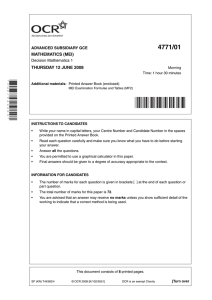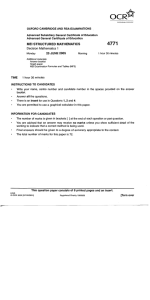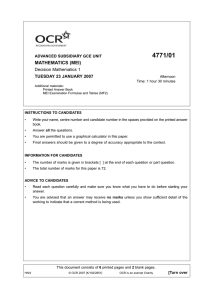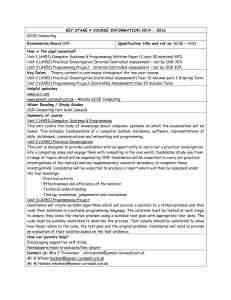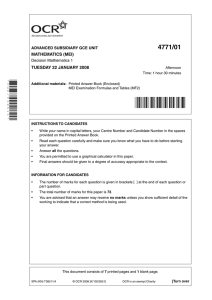4771/01 MATHEMATICS (MEI) Decision Mathematics 1 MONDAY 18 JUNE 2007
advertisement
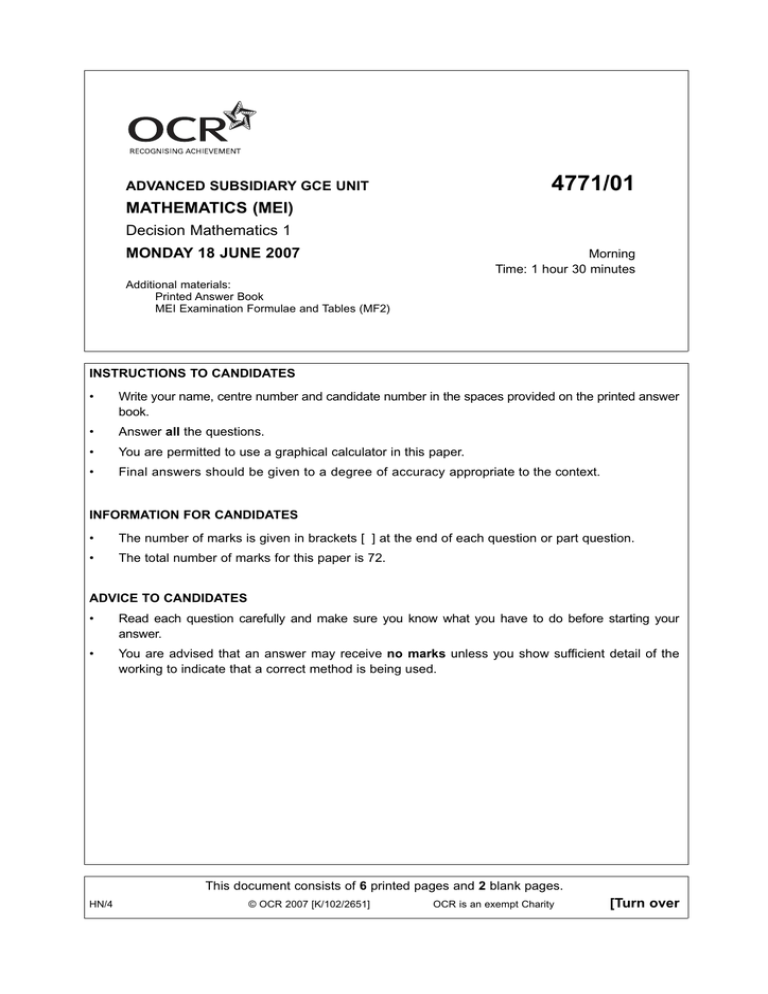
4771/01 ADVANCED SUBSIDIARY GCE UNIT MATHEMATICS (MEI) Decision Mathematics 1 MONDAY 18 JUNE 2007 Morning Time: 1 hour 30 minutes Additional materials: Printed Answer Book MEI Examination Formulae and Tables (MF2) INSTRUCTIONS TO CANDIDATES • Write your name, centre number and candidate number in the spaces provided on the printed answer book. • Answer all the questions. • You are permitted to use a graphical calculator in this paper. • Final answers should be given to a degree of accuracy appropriate to the context. INFORMATION FOR CANDIDATES • The number of marks is given in brackets [ ] at the end of each question or part question. • The total number of marks for this paper is 72. ADVICE TO CANDIDATES • Read each question carefully and make sure you know what you have to do before starting your answer. • You are advised that an answer may receive no marks unless you show sufficient detail of the working to indicate that a correct method is being used. This document consists of 6 printed pages and 2 blank pages. HN/4 © OCR 2007 [K/102/2651] OCR is an exempt Charity [Turn over 2 Answer all the questions in the printed answer book provided. Section A (24 marks) 1 Bus routes connect towns A and B and towns A and C. Train lines connect towns B and D, towns C and D, and towns A and C. John represents this information in a graph with four nodes, one for each town, in which an arc is drawn for each connection, giving five arcs in all. (i) Draw John’s graph. [2] (ii) Is John’s graph simple? Justify your answer. [2] Jamil represents the information in a graph with five nodes. He uses one node for each of towns A, B and D. Because in town C the bus station and train station are some distance apart, he uses a node labelled C(bus) and a node labelled C(train). Again there are 5 arcs, each representing a connection. 2 (iii) Draw Jamil’s graph. [2] (iv) Is Jamil’s graph a tree? Justify your answer. [2] Two hikers each have a 25 litre rucksack to pack. The items to be packed have volumes of 14, 6, 11, 9 and 6 litres. (i) Apply the first fit algorithm to the items in the order given and comment on the outcome. [3] (ii) Write the five items in descending order of volume. Apply the first fit decreasing algorithm to find a packing for the rucksacks. [3] (iii) The hikers argue that the first fit decreasing algorithm does not produce a fair allocation of volumes to rucksacks. Produce a packing which gives a fairer allocation of volumes between the two rucksacks. Explain why the hikers might not want to use this packing. [2] 3 Use a graphical approach to solve the following LP. Maximise 2 x + 3 y subject to x + 5 y x + 2y 3x + y x y © OCR 2007 4771/01 June 07 [8] 14 8 21 0 0 3 Section B (48 marks) 4 Colin is setting off for a day’s sailing. The table and the activity network show the major activities that are involved, their durations and their precedences. A Rig foresail B Lower sprayhood C Start engine D Pump out bilges E Rig mainsail F Cast off mooring ropes G Motor out of harbour H Raise foresail I Raise mainsail J Stop engine and start sailing H 3 A 3 B 2 J 1 I 4 E 1 C 3 F 1 G 10 D 4 (i) Complete the table in your answer book showing the immediate predecessors for each activity. [3] (ii) Find the early time and the late time for each event. Give the project duration and list the critical activities. [6] When he sails on his own Colin can only do one thing at a time with the exception of activity G, motoring out of the harbour. (iii) Use the activity network to determine which activities Colin can perform whilst motoring out of the harbour. [1] (iv) Find the minimum time to complete the activities when Colin sails on his own, and give a schedule for him to achieve this. [2] (v) Find the minimum time to complete the activities when Colin sails with one other crew member, and give a schedule for them to achieve this. [4] © OCR 2007 4771/01 June 07 [Turn over 4 5 The table shows the weights on the arcs of a network. A B C D E F G A – 11 – – 10 3 5 B 11 – 8 5 – – 14 C – 8 – 2 – 7 – D – 5 2 – 6 – – E 10 – – 6 – 6 – F 3 – 7 – 6 – – G 5 14 – – – – – (i) Draw the network. [3] (ii) Apply Dijkstra’s algorithm to find the least weight route from G to D. (Do this on the network you drew for part (i).) Give your route and its total weight. [6] (iii) Find by inspection the route from G to D such that the minimum of the weights for arcs on the route is as large as possible. Give your route and its minimum arc weight. Give an application in which this might be needed. [3] (iv) Consider how Dijkstra’s algorithm could be modified to solve the problem in part (iii). Explain how to update working values. Explain how to select the next vertex to be permanently labelled. [4] © OCR 2007 4771/01 June 07 5 6 In winter in Metland the weather each day can be classified as dry, wet or snowy. The table shows the probabilities for the next day’s weather given the current day’s weather. next day’s weather current day’s weather dry wet snowy dry wet snowy 4 10 2 10 2 7 3 10 5 10 2 7 3 10 3 10 3 7 You are to use two-digit random numbers to simulate the winter weather in Metland. (i) Give an efficient rule for using two-digit random numbers to simulate tomorrow’s weather if today is (A) dry, [2] (B) wet, [2] (C) snowy. [3] (ii) Today is a dry winter’s day in Metland. Use the following two-digit random numbers to simulate the next 7 days’ weather in Metland. [4] 23 85 98 99 56 47 82 14 03 12 (iii) Use your simulation from part (ii) to estimate the proportion of dry days in a Metland winter. [1] (iv) Explain how you could use simulation to produce an improved estimate of the proportion of dry days in a Metland winter. [2] (v) Give two criticisms of this model of weather. © OCR 2007 4771/01 June 07 [2] 6 BLANK PAGE © OCR 2007 4771/01 June 07 7 BLANK PAGE © OCR 2007 4771/01 June 07 8 Permission to reproduce items where third-party owned material protected by copyright is included has been sought and cleared where possible. Every reasonable effort has been made by the publisher (OCR) to trace copyright holders, but if any items requiring clearance have unwittingly been included, the publisher will be pleased to make amends at the earliest possible opportunity. OCR is part of the Cambridge Assessment Group. Cambridge Assessment is the brand name of University of Cambridge Local Examinations Syndicate (UCLES), which is itself a department of the University of Cambridge. © OCR 2007 4771/01 June 07 4771/01 ADVANCED SUBSIDIARY GCE UNIT MATHEMATICS (MEI) Decision Mathematics 1 ANSWER BOOK MONDAY 18 JUNE 2007 Morning Time: 1 hour 30 minutes Candidate Name Candidate Number Centre Number INSTRUCTIONS TO CANDIDATES • • Write your name, centre number and candidate number in the spaces provided above. Write your answers in the spaces provided on the answer book. If extra space is required use the blank page making sure that you label your work clearly. For Examiner’s Use Qu. Mark 1 2 3 4 5 6 Total This answer book consists of 7 printed pages and 1 blank page. HN/5 © OCR 2007 [K/102/2651] OCR is an exempt Charity [Turn over 2 1 (i) (ii) (iii) (iv) © OCR 2007 4771/01 Answer Book June 07 3 2 (i) Rucksack 1: Rucksack 2: Comment: (ii) Order: Rucksack 1: Rucksack 2: (iii) Rucksack 1: Rucksack 2: Explanation: © OCR 2007 4771/01 Answer Book June 07 [Turn over 4 3 Maximum value of 2x + 3y: This occurs where x = and where y = © OCR 2007 4771/01 Answer Book June 07 5 4 (i) Duration (minutes) Activity A Rig foresail 3 B Lower sprayhood 2 C Start engine 3 D Pump out bilges 4 E Rig mainsail 1 F Cast off mooring ropes 1 G Motor out of harbour 10 H Raise foresail 3 I Raise mainsail 4 J Stop engine and start sailing 1 Immediate predecessors (ii) H 3 A 3 B 2 J 1 I 4 E 1 C 3 F 1 G 10 D 4 Project duration: Critical activities: (iii) Activities whilst motoring: (iv) Minimum time: Schedule for Colin: (v) Minimum time: Schedule for Colin: Schedule for crew member: © OCR 2007 4771/01 Answer Book June 07 [Turn over 6 5 (i) & (ii) A G B F C E Route: (iii) Route: D Weight: Weight: Application: (iv) Working value update Next vertex to label © OCR 2007 4771/01 Answer Book June 07 7 6 (i) (A) (B) (C) (ii) (iii) (iv) (v) © OCR 2007 4771/01 Answer Book June 07 8 BLANK PAGE © OCR 2007 4771/01 Answer Book June 07 Mark Scheme 4771 June 2007 94 4771 Mark Scheme June 2007 1. (i) A B D C M1 A1 (ii) No. Two arcs AC. (iii) A 4 nodes and 5 arcs M1 A1 B M1 5 nodes and 5 arcs C(bus) D (iv) A1 C(train) No. ABDC(train)A is a cycle. M1 A1 (i) Rucksack 1: 14; 6 Rucksack 2: 11; 9 final item will not fit. M1 A1 B1 6 must be in R1 (ii) Order: 14, 11, 9, 6, 6 Rucksack 1: 14; 11 Rucksack 2: 9; 6; 6 B1 M1 A1 ordering 11 in R1 (iii) Rucksack 1: 14; 9 Rucksack 2: 11; 6; 6 e.g. weights. B1 2. B1 3. y (4, 2) 14 4 2.8 (6.8, 0.6) 15.4 8.4 14 7 14 8 Optimum of 15.4 at x = 6.8 and y = 0.6. 95 x B1 axes scaled & used M1 lines A1 B1 shading M1 two intersection A1 points M1 solution A1 (or by using the objective gradient to identify the optimal point) 4771 Mark Scheme June 2007 4. (i) Activity A B C D E F G H I J Duration (minutes) 3 2 3 4 1 1 10 3 4 1 Rig foresail Lower sprayhood Start engine Pump out bilges Rig mainsail Cast off mooring ropes Motor out of harbour Raise foresail Raise mainsail Stop engine and start sailing (ii) 3 A 0 B 2 0 C 3 3 18 18 6 2 3 Immediate predecessors – – – C B A, C, E D, F A E G, H, I H 3 5 E 1 3 3 A, B, C, D, E, H & I B1 F B1 G and J M1 A1 forward pass J 1 I 4 6 6 B1 F 1 7 7 17 17 M1 A1 backward pass G 10 D 4 Critical activities: C; D; G; J Project duration: 18 minutes B1 B1 (iii) H and I B1 (iv) 25 mins B1 Must do A, B, E, C, F, D (in appropriate order) then H and I with G, then J. B1 18 mins B1 e.g. B1 B1 B1 (v) Colin does C, D Crew does A, B, E, F Thence G et al 96 4771 Mark Scheme June 2007 5. (i) & (ii) 2 5 5 A 5 1 or 5 11 0 G B 4 14 14 14 10 3 M1 A1 arcs A1 arc weights 8 5 3 8 8 6 15 C 15 7 F 6 2 or 4 5 14 15 14 E 6 D 20 M1 A1 A1 A2 Dijkstra labels order of labelling working values 7 17 19 17 if E is fourth Route: G A F C D B1 B1 Weight: 17 (iii) Route: G B C F E D or G B A E D Weight: 6 Any capacitated route application. B1 B1 B1 (iv) Compute min(label, arc) and update working value if result is larger than current working value. Label unlabelled vertex with largest working value. B1 B1 97 B1 4771 Mark Scheme June 2007 6. (i)(a) e.g. Dry: 00 – 39 Wet: 40 – 69 Snowy: 70 – 99 M1 A1 proportions efficient (b) e.g. Dry: 00 – 19 Wet: 20 – 69 Snowy: 70 – 99 M1 A1 proportions efficient (c) e.g. Dry: Wet: Snowy: Reject: M1 A1 A1 reject some proportions reject 2 M1 applying their rules sometimes dry rules wet rules snowy rules (ii) 00 – 27 28 – 55 56 – 97 98 & 99 D (today) → D → S → S → W → S → D → D A1 A1 A1 (iii) 3/7 (or 4/8) B1 (iv) a (much) longer simulation run, with a "settling in" period ignored. (v) Defining days as dry, wet or snowy is problematical. Assuming that the transition probabilities remain constant. Weather depends on more than just previous day's weather B1 B1 B1 B1 98 Report on the Units taken in June 2007 4771: Decision Mathematics 1 General Comments Candidates were able to cope well with this examination. Most had been well prepared and were able to collect a high proportion of the marks allocated for the more fundamental parts of the questions. There were a small number of "extension" marks which very few candidates were able to score. This was the second delivery in which candidates were provided with a printed answer book. Again, it worked well. There were still one or two centres which had all of their candidates append 8 page answer booklets to their printed answer books. As before these were a nuisance, since they seldom contained anything more than a few notes, whilst requiring examiners to check and annotate each page. If candidates run out of space for a question they should write on the blank page(s) at the end of the printed answer book. Only if this proves insufficient should a 4 page answer booklet be issued. Comments on Individual Questions 1 Graphs Almost all candidates could draw the graphs in parts (i) and (iii). A few forfeited all marks in parts (ii) and/or (iv) by not realising that the first graph was not simple and the second not a tree. Many who did get the correct "no" answers were unable to mount adequate justifications. There was much confusion between loops and cycles. 2 3 Algorithms (i) Most were successful with first fit. (ii) Most were successful, but several implemented first fit increasing. (iii) Most were able to give the required packing, but only about 50% offered weight as an alternative criterion for packing. Some thought it iniquitous that one hiker would have to carry 3 items and the other only 2! They were denied the mark. Others went on flights of fancy concerning the possible natures of the items being packed. These also failed to gain the mark. LP There was a range of responses to this question. Most were able to make a decent attempt at drawing the graph, although candidates' shadings were sometimes difficult to discern. Fewer showed evidence of trying to compute or read off the coordinates of the relevant points. A similar proportion failed to show evidence of how the best point was selected. There were few instances of candidates losing marks through inaccurate drawing. It should be noted that it is not necessary to use (0,21) to draw a graph of 3x + y = 21. Plenty of other points are available, e.g. (4,9), (5,6), (6,3) etc. Scaling axes so as to use (0,21) leads to a very small feasible region. 55 Report on the Units taken in June 2007 4 CPA (i) (ii) (iii) (iv) (v) Most candidates were successful in listing immediate predecessors. Of those that failed rather more showed a complete lack of understanding than those who gave complete list of predecessors. Whilst most were able successfully to complete forward and backward passes, a substantial minority failed, particularly with the backward pass. With some weak candidates examiners had to be vigilant to see which box was being used for which pass. These parts were all concerned with scheduling. Part (iii) was straightforward, but many candidates either found parts (iv) and (v) less easy, or were unable adequately to communicate their schedules. 5 Networks (i) This was very easy. Nevertheless, it was pleasing that so few candidates failed to score full marks on it. (ii) Examiners had to struggle through the usual crop of answers in which it was not clear whether or not Dijkstra had been used. It is particularly important for candidates to show their order of labelling, and for them only to write in new working values when the new do replace the old. (iii) Surprisingly few candidates scored the marks for this part of the question. Most who attempted it tried to find a maximum weight route (which would not be well defined), as against the required maximin route. (iv) Many candidates were able to score the second and third marks here. Only one or two were able to define the potential new working value for the first mark. 6 Simulation (i) Most candidates gave correct "dry" and "wet" routes. As always, a proportion failed when it was necessary to reject some random numbers. (ii) The pitfalls of examining! We were ready and waiting for those candidates who failed to reject the 98 and the 99, having the consequential weather string ready for "follow-through" marks. We were several candidates into the marking procedure before it was realised that candidates who had the correct rules, but who only ever applied the "dry" rule, were producing the same string! Thankfully it was possible to determine what was going on, and to allocate marks accordingly. (iii) Not all candidates gave a probability in answering this, the worst being those who gave 3:7 instead of 3/7. (3:4 was never seen!) (iv) Nearly all candidates gave "repetition", though many took quite a bit more than a word, or even a sentence, to say it. Only one or two made reference to the initial condition. (v) Many made reference to the concept of classifying a day as "dry", etc. They were given a mark even if they failed to get to grips with the issue. They were given it only once, even if they referred to many separate aspects of this issue, as many did. Some criticised the assumption that the transition probabilities remain constant, although the examiners often had to be generous in their interpretations of what had been written to award a mark – e.g. "global warming"? Those that stated that the probabilities would be different in different seasons were not given credit – they had not read the question. The most difficult issue for the examiners concerned those who questioned the Markov nature of the model. Anyone who said, for instance, that the weather today might also depend on the weather two days ago would clearly have been worth a mark – such a candidate would have in mind, at least implicitly, a 56 Report on the Units taken in June 2007 second order recurrence relation. On the other hand a candidate with the same thoughts might well have written down "The model only takes account of yesterday's weather". That was thought not to be worth credit, being a statement of fact. Some thought that having sets of probabilities with different denominators was worthy of criticism. 57


